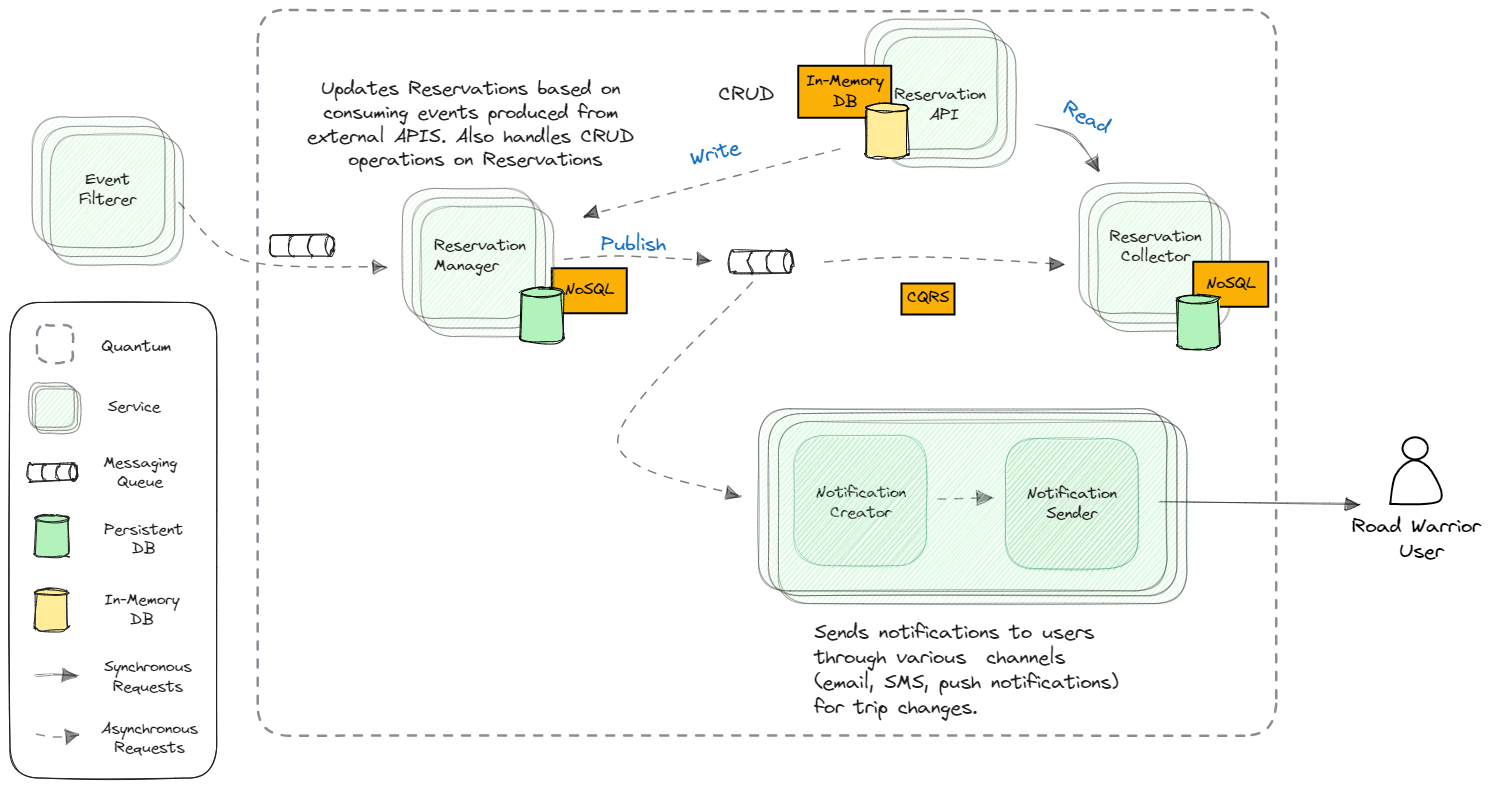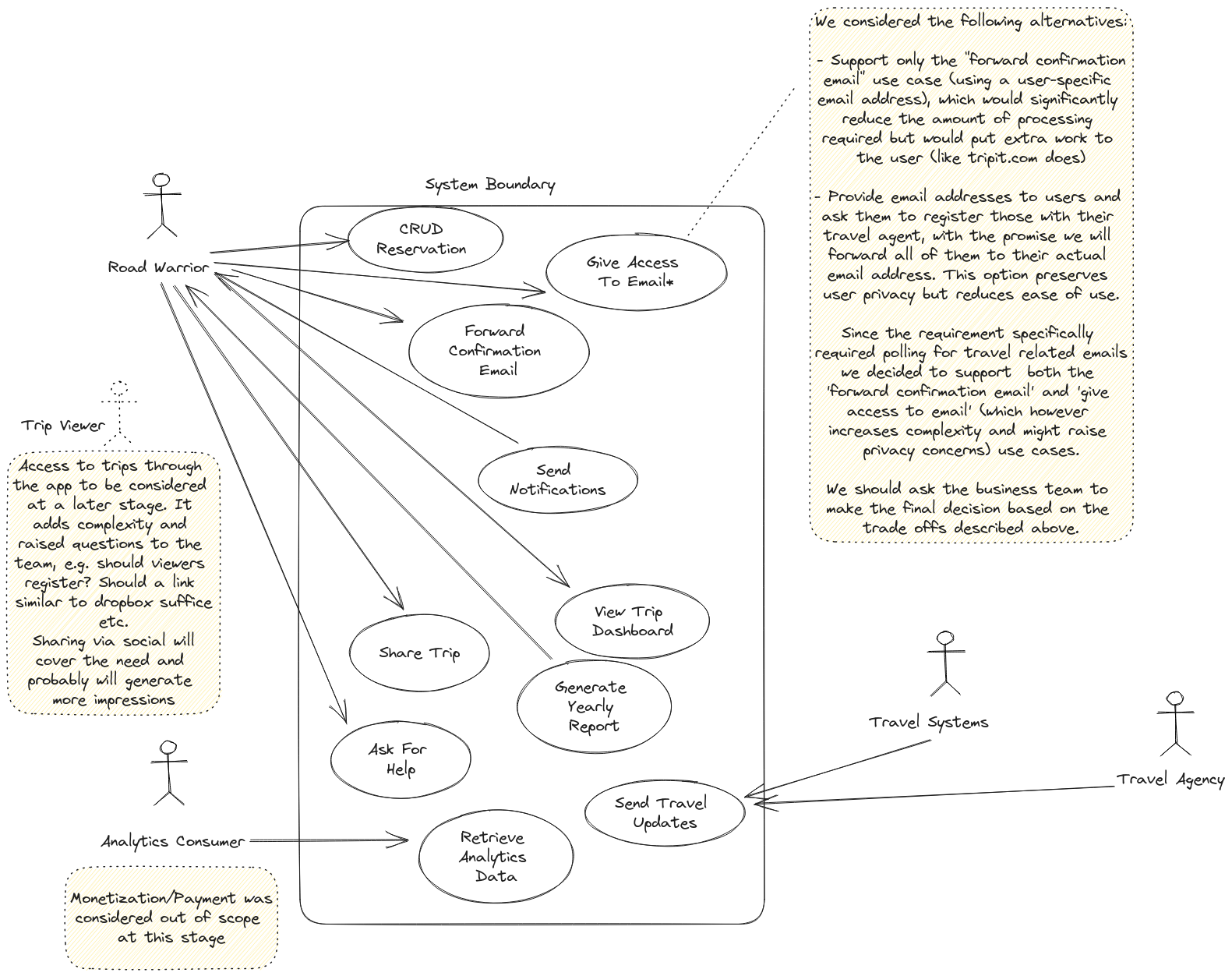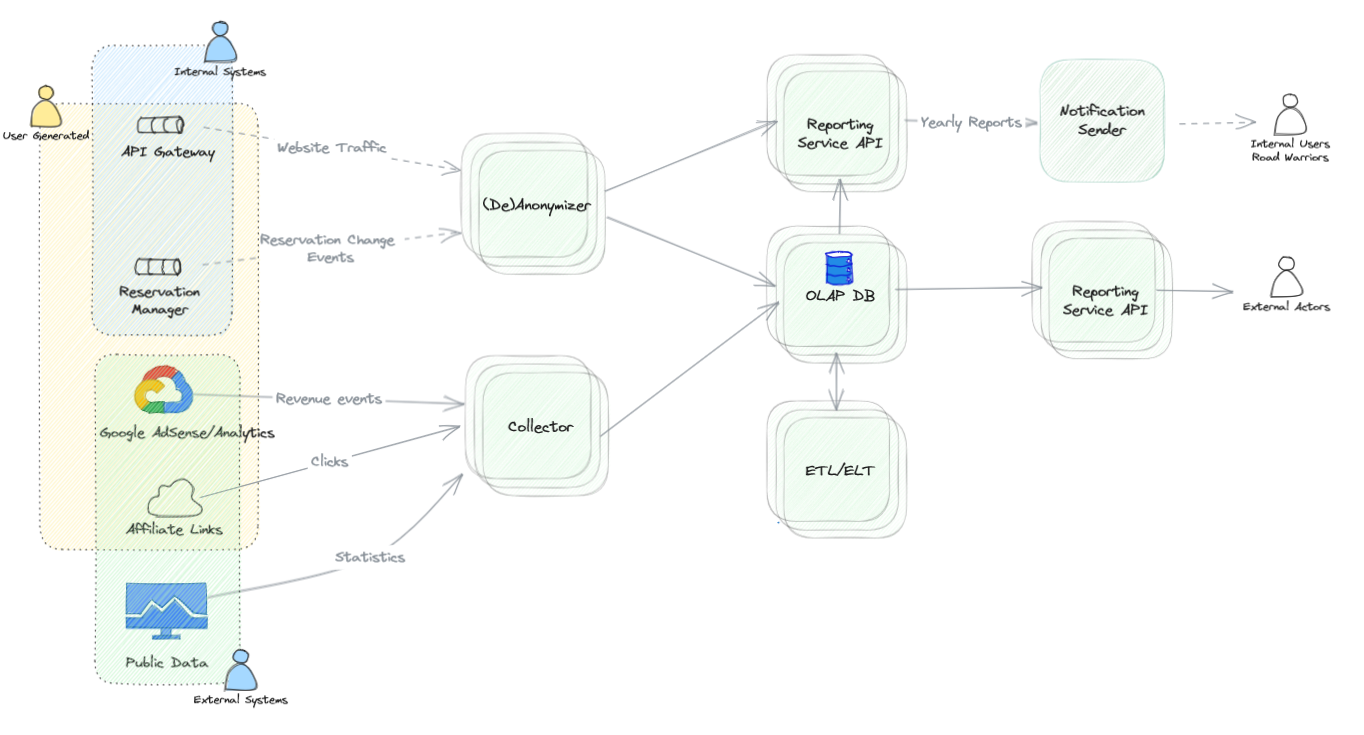This repository is our solution to the Fall 2023 O'Reilly Architectural Katas Challenge.
The goal of the challenge is to enable Road Warrior, a startup aspiring to be a single source of truth for all things related to the trips of its users, to meet its objective.
Our team consists of Apostolos Mantes, George Lourakis, George Panagiotakis, Konstantinos Polydorou and Spyros Economopoulos. We are members of Neurocom SA, a greek company focusing mainly on the telecommunication sector, located in Greece.
Be the single source of truth for all things trip related.
At this stage focus on
- flights
- hotels
- car rentals
Keep in mind the vision and consider how the platform will embrace trains, buses, attractions etc. etc.
The identified actors and use cases appear in the following diagram
Which led to the identification of the initial building blocks of the system
We utilized the quantum concept during our analysis to identify parts of the system that serve different needs and demonstrate different characteristics.
This is the final list along with each quantum responsibilities
- User Agent
- Interact with the user (display dashboard, receive commands etc.)
- Capture analytics metrics
- Store and publish user profiles
- Share content to social media via related APIs
- Redirect user to preferred agent website (retrieved from user profile) when asking for help
- Travel Updates Receiver
- Connect with travel agent and travel systems
- Receive notifications and filter the ones of interest
- Translate notifications to the system internal format and push them to the reservation orchestrator
- Email Receiver
- Connect to our email server and poll for forwarded reservations
- Connect to user mailboxes and filter out travel related emails (reservation + updates)
- Translate message information to the system internal format and push them to reservation orchestrator
- Reservation Orchestrator
- Receive user requests from the user agent and return relevant information
- Receive user commands from the user quantum and update trips/reservations accordingly
- Receive messages from travel notifications and email receivers and update trip accordingly
- Analytics Capture
- Collect analytics data from user agent, email receiver and travel update receiver quanta and store them for analysis
- Anonymize data for use with analytics consumers
- Prepare yearly reports and push them to end users through the user agent
- 2 Million Weekly Active Users
- 15 Million Total Users
- 800 ms web response time
- 1.4 sec mobile app contentful paint
- 5 minutes end to end update limit
- 99.99% ("four nines") availability
We assume that most, e.g. 80%, of the users will mostly interact with the app within a four - hour time frame in working days corresponding to 1.6M users accessing the site in 5 * 4 * 3600 = 72K sec, leading to an expected number of 25 requests / second.
We do not expect a sudden burst of requests, maybe an increase in holiday periods but certainly not something we will make us have to respond immediately.
Assuming an average of 5 reservations per active user (to accommodate attractions or events) and an average trip duration of two weeks we expect 2 million * 5 = 10 million reservations per two weeks = 5 million per week (~250 million reservations per year).
We expect on average 5 updates per reservation => 25 million relevant update events per week (of course the updates we will have to process will be much higher. Suppose we have captured 5% of the market we expect 20 times this number in total, leading to 500 million update events per week), i.e. ~1000 reqs per second.
Email parsing, if we consider the 'share your mailbox approach' is much more challenging. Suppose 30% of our users have opted in for this option and that the average user receives 100 emails per day, we need to filter 30% * 5M * 100 = 150M emails per day, i.e. ~4000 reqs per second.
- The system must interoperate with as many as travel agent API's as possible
- We plan to expand to international markets
Given the above we have identified the following top three architecture characteristics:
- Availability: Since the application must be available to ensure the best customer experience
- Interoperability: Since we need to interoperate with a lot of travel agents at both national and international level
- Scalability: Since we both plan to expand and anticipate periods with higher traffic
Additional applicable characteristics that we considered were:
- Performance (especially with regard to external information sources): We decided to address it in the quantum level
- Deployability: To allow us to quickly onboard new travel agents and reservation types. This will be aided by allowing each quantum to be deployed separately (and possibly in parallel).
- Fault Tolerance: To allow the system to operate in case of e.g. network issues with external agents / travel systems and/or email providers. We consider that we can address this issue with the CRUD operation provided to the end user as well as the option to parse email updates on top of confirmation emails.
- Configurability: Since this will be an international application with different time zones, currencies, confirmation email languages etc. etc.
- Data Consistency: To avoid false notifications to alarm the user or miss important information. Again, we decided to address this issue in the corresponding quanta.
- Security: we did not identify a specific security requirement (apart from GDPR which we addressed in the analytics quantum) and email sharing which we expect to be standardized.
Based on the characteristics identified, and using the provided template, we came up with the following top matching architectures:
We decided to select a hybrid microservices event-driven architecture because it both scores well in most of our characteristics and fits well with asynchronous processing which we think is central to our application.
The system-wide architecture is depicted in the following diagram
We then focused on each quantum and discussed the characteristics that it should demonstrate. Here is what we came up with:
The following diagram describes the architecture for the user agent quantum
We identified the top architectural characteristics of this quantum to be the following:
- Deployability: Because we need to be able to perform A/B testing with different versions of the application as features are being added
- Availability: Because the application must be available 99.99% ("four nines") of the time
- Performance: To allow for 0.8s and 1.4s response time in Web and Mobile
- Configurability: To allow internationalization, different currencies etc.
More details for the user agent quantum can be found here: User Agent Quantum Details
The following diagram describes the reservations orchestrator quantum

We identified the top architectural characteristics of this quantum to be the following:
- Data Consistency: To provide accurate and up-to-date information to the user.
- Availability: Because it is the central component in the 'critical path' of the user's experience.
More details for the reservations orchestrator component can be found here: Reservations Orchestrator Quantum Details
The following diagram describes the architecture for the travel updates receiver quantum
We identified the top architectural characteristics of this quantum to be the following:
- Interoperability: Because we need to be able to interface with as many sources of relevant information as possible.
- Scalability: Because we will add additional data sources as time goes by.
More details for the travel updates receiver quantum can be found here: Update Receiver Quantum Details
The following diagram describes the architecture of the email receiver quantum
We identified the top architectural characteristics of this quantum to be the following:
- Performance: Because we have to process a lot more emails to identify the ones that are really relevant. Also we will need to process emails of all users, including inactive ones, at all times.
- Scalability: Since we expect to go international - and we consider growth is a key metric for any startup - email volume will be a multiple of user growth.
- Availability: Because
- the majority of reservations will arrive via email
- some travel agents might not provide APIs
- possible downtime in API communication will render email our last resort for updates.
More details for the email receiver quantum can be found here: Email Receiver Quantum Details
The following diagram describes the architecture for the Analytics Capture in detail.
We identified the top architectural characteristics of this quantum to be the following:
- Deployability: To accomodate processing of new information and constantly adding new reports
- Configurability: To allow internationalization, different currencies etc.
More details for the analytics capture quantum can be found here: Analytics Capture Quantum Details
Deployment strategy is an important aspect of software architecture as it impacts several aspects
of our architectural considerations such as cost, availability, scalability, reliability.
Our target is to leverage the advantages of cloud infrastructure and Kubernetes orchestration,
and its inherent flexibility, scalability to meet the demands of today's dynamic computing environments.
Deploying our system using containerized applications or serverless functions offers a flexible and efficient approach to streamline application deployment process (ADR13 Deploy Options).
Kubernetes has become increasingly popular due to the numerous benefits it offers for managing containerized workloads in a scalable, resilient, and automated manner. It becomes an even more attractive choice for our system since we can setup and utilize a service mesh (e.g. Istio) which complements container orchestration handling of Kubernetes by addressing service-to-service communication, security, and observability challenges (ADR15 Monitoring)
Moreover, it makes sense to utilize a managed Kubernetes service to deploy our system in the cloud using Kubernetes clusters across multiple geographic regions or data centers to achieve objectives like high availability, fault tolerance, and reduced latency. (ADR14 Availability Deploy Concerns)
The following figure provides an early glimpse into our deployment strategy on a cloud environment, where main components and structure are outlined here as a point of reference, as we shall continue to refine and enhance our approach.
The following list contains architecture decision records (ADRs) created as part of the architecture design process in the system or quantum level.
- ADR01 Hybrid Architecture
- ADR02 API-Gateway
- ADR03 CDN
- ADR04 Rest
- ADR05 Web and Native Mobile Apps
- ADR06 Server Sent Events
- ADR07 External-API-Integration
- ADR08 CQRS
- ADR09 Message Broker
- ADR10 Specialized DBs
- ADR11 Analytics OLAP
- ADR12 GDPR
- ADR13 Deploy Options
- ADR14 Availability Deploy Concerns
- ADR15 Monitoring
- ADR16 Mail Polling








